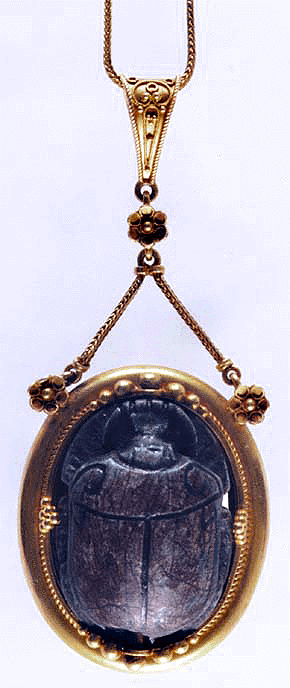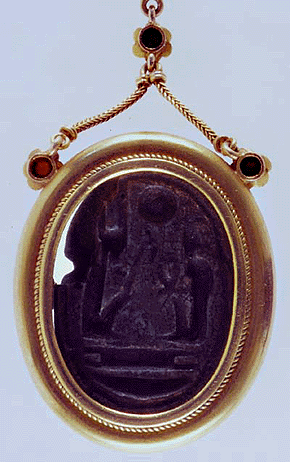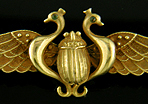
Egyptian Revival Scarab Pendant
Mystery of the Pharaohs! |
|
|
For centuries the arts and artifacts of ancient Egypt have inspired jewelers and goldsmiths. During the Victorian era, archaeological discoveries influenced the Egyptian Revival jewelry of the 1870s. The above scarab pendant is a wonderful example.
The scarab is an ancient amulet and a symbol of rebirth and the afterlife. Perhaps it was found by a Victorian adventurer as she or he explored the ancient ruins along the Nile. The scarab is set in an 18kt gold jewel masterfully crafted in the Egyptian Revival style. Note the twisted wire work and use of small gold balls. These decorative elements are characteristic of Victorian revival jewelry. Based on the design of the pendant and the purity of the gold, we believe this exquisite jewel was created by an English goldsmith during the 1870s. |
|
| Cost: | Sold | |
|
Measurements: |
||
|
This wonderful pendant and chain are crafted in 18kt gold. The oval frame of the jewel measures 1.25" by 1.0625" and the depth of the pendant and scarab is approximately 0.5". The length from the top of the bail to the bottom of the pendant is 2.5" inches. The pendant hangs from an 18" foxtail link chain. |
||

|
The jeweler left the rear of the pendant open so that you could see the inscription on the underside of the scarab. Note the twisted wire edge (also known as gold rope work) that frames the scarab. The pendant is as beautiful from the back as it is from the front.
Interpreting ancient Egyptian inscriptions and hieroglyphics is not one of our areas of expertise. So, we can't tell you the meaning of the carving on the back of the scarab. However, if you can help us with this, we would love to hear from you. Just send us an email. (See one helpful interpretation below.) |
|
|
|
*******
The new owners of this pendant have a passion for ancient Egypt and were kind enough to offer the following interpretation of the inscriptions on the back of the scarab:
"To provide a partial answer to the question posed on your web site: The figure on the left is a pharaoh, as can be determined by the crown [partially broken away - The Egyptian dynastic period started with the unification of upper and lower Egypt around 3700 BCE. This was symbolized by the unification of the red and white crowns representing the upper and lower reaches of the Nile. The figure on the scarab appears to be wearing the red crown.], by the crook [the crook and the flail were symbols of office like the orb and scepter in the English crown jewels], and by the ceremonial beard, which even the rare female rulers would wear. |
| Bob and Sue |
Another eminent student of Egyptology, from Great Britain, offers the following discussion of the scarabs inscription:
The scarab is inscribed with one of the throne names (i.e. one of the two names normally written in a cartouches) of the 19th Dynasty Pharoah usually known, from his other throne name, as Ramses VI who reigned circa 1200 BC. |
| Mark |
|
|
||
|
| Jewelry Galleries | Victorian Jewelry | Next Jewel | | Bijoux Home Page | Site Map | What's New! | If you have any questions, suggestions or comments, please give us a call (603 624-8672) or send us an email.
|
||
|
|
||

